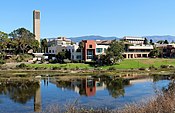| Revision as of 21:38, 19 July 2015 editScientist999 (talk | contribs)444 edits →Academics← Previous edit | Revision as of 21:41, 19 July 2015 edit undoScientist999 (talk | contribs)444 edits →Graduate academicsNext edit → | ||
| Line 12: | Line 12: | ||
| ===Graduate academics=== | ===Graduate academics=== | ||
| The graduate program was ranked fifth (or sixth, depending on which method used) among physics program in the 2011 study by the National Research Council.<ref></ref> U.S. News & World Report ranked the graduate program tenth in the country across all subfields, third in Condensed Matter Physics, fifth in Quantum Physics, eighth in Elementary Particles/Field/String Theory, and ninth in Cosmology/Relativity/Gravity.<ref></ref> | The graduate program was ranked fifth (or sixth, depending on which method used) among physics program in the 2011 study by the National Research Council.<ref></ref> U.S. News & World Report ranked the graduate program tenth in the country across all subfields, third in Condensed Matter Physics, fifth in Quantum Physics, eighth in Elementary Particles/Field/String Theory, and ninth in Cosmology/Relativity/Gravity.<ref></ref> The graduate program awarded a total of 20 Ph.D. degrees in 2013. | ||
| ==Research Programs and Institutes == | ==Research Programs and Institutes == | ||
Revision as of 21:41, 19 July 2015
The Physics Department at the University of California, Santa Barbara has 58 faculty members. It offers academic programs leading to the B.A., B.S., and Ph.D. degrees.
Faculty Awards
As of 2014, the department counts three Nobel Prize winners among its faculty: David Gross (2004, Physics), Alan J. Heeger (2000, Chemistry), and Walter Kohn (1998, Chemistry). Physics Nobel Prize winners Herbert Kroemer (2000) and Shuji Nakamura (2014) are both professors of Electrical and Computer Engineering and Materials Departments at UCSB. The Physics Department's faculty includes 13 members of the National Academy of Sciences: Guenter Ahlers, Matthew Fisher, David Gross, James Hartle, Alan Heeger, Gary Horowitz, Joseph Incandela, Walter Kohn, James Langer, Joseph Polchinski, Douglas Scalapino, Boris Shraiman, and Michael Witherell. Heeger is also a member of the National Academy of Engineering. Guenter Ahlers, Matthew Fisher, David Gross, Gary Horowitz, Walter Kohn, James Langer, Joseph Polchinski, Douglas Scalapino, and Anthony Zee have all been elected to membership in the American Academy of Arts and Sciences. Joseph Incandela shared the 2012 Special Breakthrough Prize in Fundamental Physics with six other physicists for the discovery of the Higgs boson.
Academics
Undergraduate academics
The standard program, which is in the College of Letters and Science (L&S), leads to either a B.A. or B.S. degree. The B.S. program is for those aiming for a career in physics, while the B.A. is a more flexible program allowing more courses from other areas. Within the B.S. program there are three possible schedules of courses - a standard track, an advanced track, and an honors track - leading to a degree in four years. These tracks include increasingly more electives and undergraduate research. UCSB conferred 66 bachelor's degrees in physics in 2013, which represents the sixth largest graduating physics class among U.S. universities.
Graduate academics
The graduate program was ranked fifth (or sixth, depending on which method used) among physics program in the 2011 study by the National Research Council. U.S. News & World Report ranked the graduate program tenth in the country across all subfields, third in Condensed Matter Physics, fifth in Quantum Physics, eighth in Elementary Particles/Field/String Theory, and ninth in Cosmology/Relativity/Gravity. The graduate program awarded a total of 20 Ph.D. degrees in 2013.
Research Programs and Institutes
The faculty members conduct and supervise research in Astrophysics, Cosmology, Biophysics, Condensed Matter Physics, Gravitation, and Particle Physics. In 2011 The Academic Ranking of World Universities ranked the UCSB department eleventh in the world, ninth in the United States. In a ranking of physics departments by citations per faculty member, UCSB is first with 178 citations per faculty member.
Physics professor David Gross was Director of the Kavli Institute for Theoretical Physics (KITP) until 2012, and its permanent members are also faculty of the Physics Department. David Awschalom, professor in the physics department, is Director of the California NanoSystems Institute at UC Santa Barbara, and several members of the physics faculty carry out their research program within CNSI. The Institute for Terahertz Science and Technology is the research home for many other faculty members in the physics department.
Four faculty members from the department lead a large UCSB research group working at the Large Hadron Collider using the Compact Muon Solenoid (CMS). UCSB Professor Joseph Incandela is the spokesperson for the CMS collaboration. On 4 July 2012, Incandela spoke on behalf of CMS, where the discovery of a previously unknown boson with mass 125.3 ± 0.6 GeV/c was announced.
References
- UCSB Physics Department home page
- Nobel Prizes in Physics
- Nobel Prizes in Chemistry
- National Academy of Sciences Member Directory
- National Academy of Engineering Member Directory
- American Academy of Arts and Sciences Member Directory
- Special Breakthrough Prize in Fundamental Physics
- Undergraduate Education
- American Institute of Physics, Roster of Physics Departments, 2013
- NRC Physics Rankings
- US News Rankings of Graduate Programs in Physics
- Graduate Education
- Academic Ranking of World Universities in Physics - 2011
- Physics Program Rankings
- The KITP web site
- CNSI-UCSB
- Institute for Terahertz Research and Technology
